Critical Review of the Impact of COVID-19 Burden in Australia
VerifiedAdded on 2023/06/07
|10
|3463
|474
Literature Review
AI Summary
This assignment provides a critical review of the COVID-19 burden in Australia, examining the impact on the health sector, mortality rates, and government strategies to combat the pandemic. It begins with an introduction to the global context of the pandemic, highlighting the role of the World Health Organization and the initial response in Australia. The research methodology outlines the objectives, questions, and approaches used, including data collection from sources like Google Scholar and government websites. The review analyzes the government's preventative measures, mortality rates, and the disease burden in Australia. The literature review explores themes such as mortality rates, the impact on the health sector, strategies to restrict the spread of COVID-19, and recovery strategies. The study concludes with recommendations based on the data analysis and findings, offering insights into the vulnerabilities of the healthcare system and the effectiveness of implemented policies.
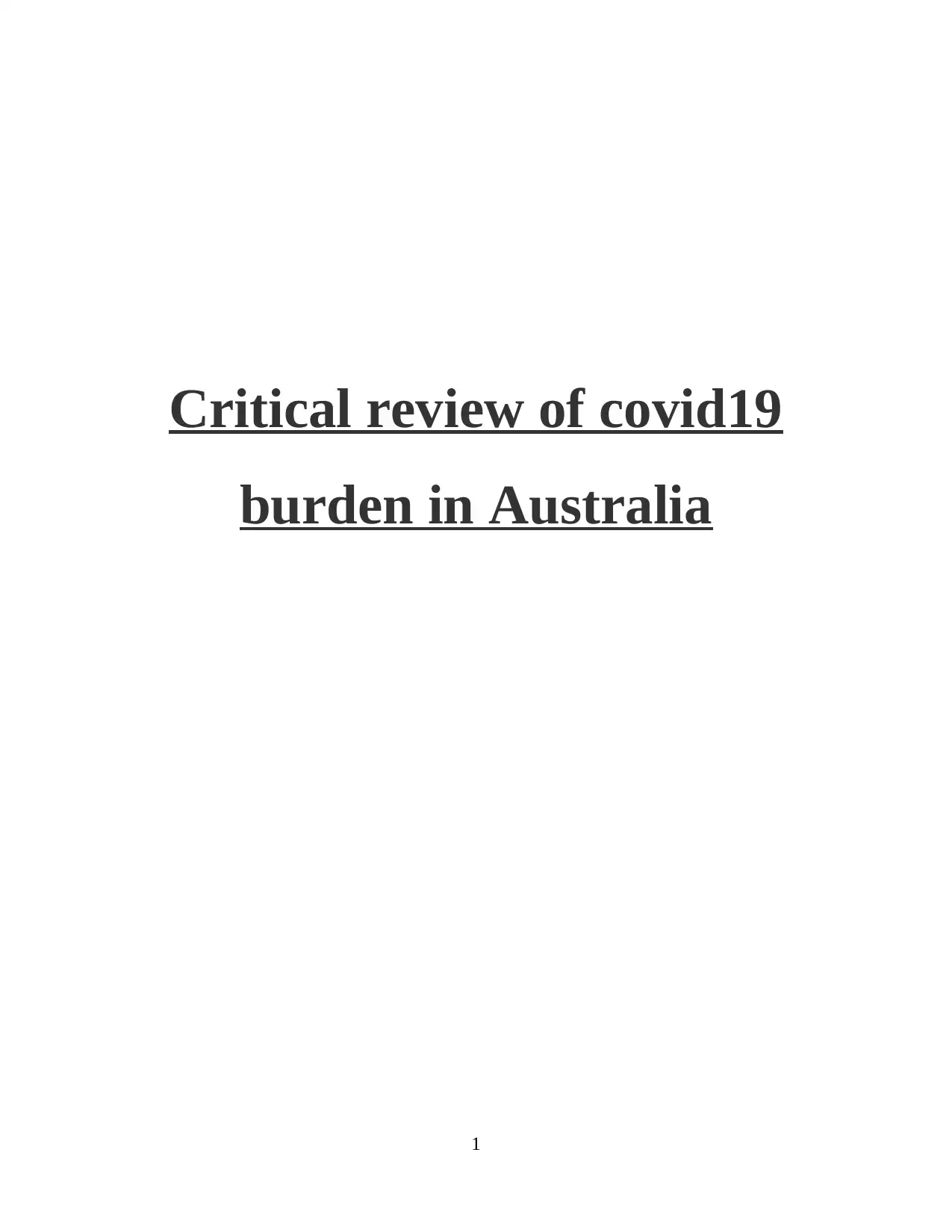
Critical review of covid19
burden in Australia
1
burden in Australia
1
Paraphrase This Document
Need a fresh take? Get an instant paraphrase of this document with our AI Paraphraser
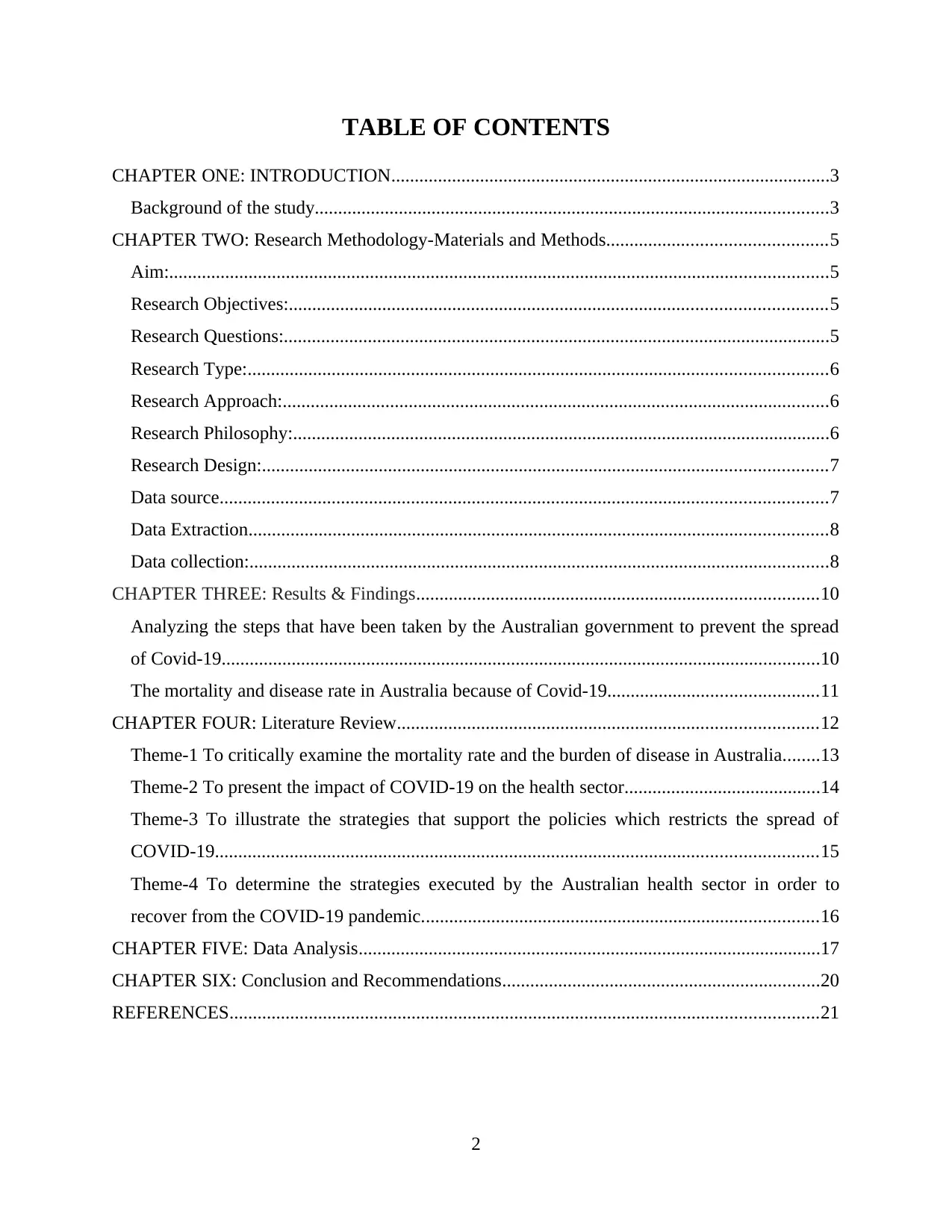
TABLE OF CONTENTS
CHAPTER ONE: INTRODUCTION..............................................................................................3
Background of the study..............................................................................................................3
CHAPTER TWO: Research Methodology-Materials and Methods...............................................5
Aim:.............................................................................................................................................5
Research Objectives:...................................................................................................................5
Research Questions:.....................................................................................................................5
Research Type:............................................................................................................................6
Research Approach:.....................................................................................................................6
Research Philosophy:...................................................................................................................6
Research Design:.........................................................................................................................7
Data source..................................................................................................................................7
Data Extraction............................................................................................................................8
Data collection:............................................................................................................................8
CHAPTER THREE: Results & Findings......................................................................................10
Analyzing the steps that have been taken by the Australian government to prevent the spread
of Covid-19................................................................................................................................10
The mortality and disease rate in Australia because of Covid-19.............................................11
CHAPTER FOUR: Literature Review..........................................................................................12
Theme-1 To critically examine the mortality rate and the burden of disease in Australia........13
Theme-2 To present the impact of COVID-19 on the health sector..........................................14
Theme-3 To illustrate the strategies that support the policies which restricts the spread of
COVID-19.................................................................................................................................15
Theme-4 To determine the strategies executed by the Australian health sector in order to
recover from the COVID-19 pandemic.....................................................................................16
CHAPTER FIVE: Data Analysis...................................................................................................17
CHAPTER SIX: Conclusion and Recommendations....................................................................20
REFERENCES..............................................................................................................................21
2
CHAPTER ONE: INTRODUCTION..............................................................................................3
Background of the study..............................................................................................................3
CHAPTER TWO: Research Methodology-Materials and Methods...............................................5
Aim:.............................................................................................................................................5
Research Objectives:...................................................................................................................5
Research Questions:.....................................................................................................................5
Research Type:............................................................................................................................6
Research Approach:.....................................................................................................................6
Research Philosophy:...................................................................................................................6
Research Design:.........................................................................................................................7
Data source..................................................................................................................................7
Data Extraction............................................................................................................................8
Data collection:............................................................................................................................8
CHAPTER THREE: Results & Findings......................................................................................10
Analyzing the steps that have been taken by the Australian government to prevent the spread
of Covid-19................................................................................................................................10
The mortality and disease rate in Australia because of Covid-19.............................................11
CHAPTER FOUR: Literature Review..........................................................................................12
Theme-1 To critically examine the mortality rate and the burden of disease in Australia........13
Theme-2 To present the impact of COVID-19 on the health sector..........................................14
Theme-3 To illustrate the strategies that support the policies which restricts the spread of
COVID-19.................................................................................................................................15
Theme-4 To determine the strategies executed by the Australian health sector in order to
recover from the COVID-19 pandemic.....................................................................................16
CHAPTER FIVE: Data Analysis...................................................................................................17
CHAPTER SIX: Conclusion and Recommendations....................................................................20
REFERENCES..............................................................................................................................21
2
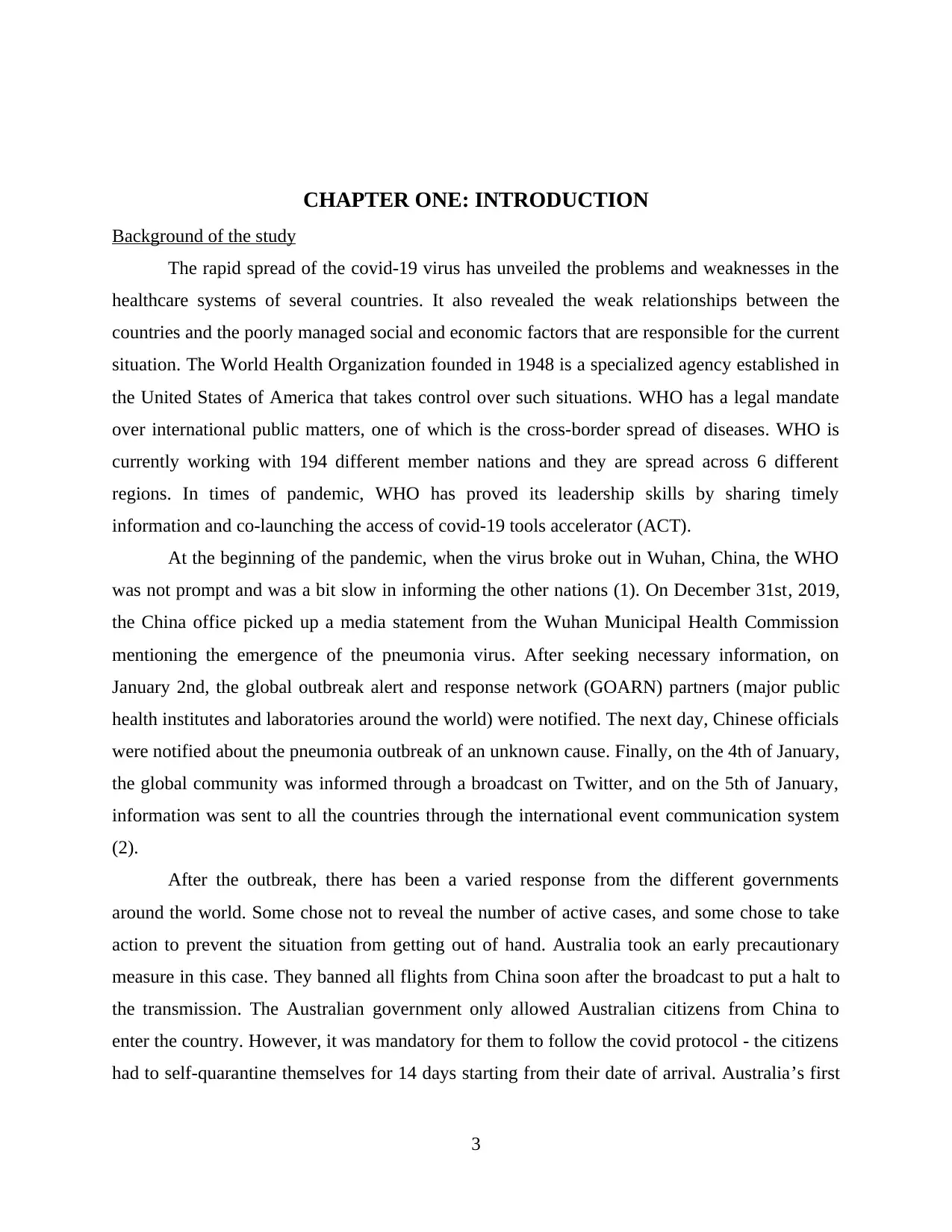
CHAPTER ONE: INTRODUCTION
Background of the study
The rapid spread of the covid-19 virus has unveiled the problems and weaknesses in the
healthcare systems of several countries. It also revealed the weak relationships between the
countries and the poorly managed social and economic factors that are responsible for the current
situation. The World Health Organization founded in 1948 is a specialized agency established in
the United States of America that takes control over such situations. WHO has a legal mandate
over international public matters, one of which is the cross-border spread of diseases. WHO is
currently working with 194 different member nations and they are spread across 6 different
regions. In times of pandemic, WHO has proved its leadership skills by sharing timely
information and co-launching the access of covid-19 tools accelerator (ACT).
At the beginning of the pandemic, when the virus broke out in Wuhan, China, the WHO
was not prompt and was a bit slow in informing the other nations (1). On December 31st, 2019,
the China office picked up a media statement from the Wuhan Municipal Health Commission
mentioning the emergence of the pneumonia virus. After seeking necessary information, on
January 2nd, the global outbreak alert and response network (GOARN) partners (major public
health institutes and laboratories around the world) were notified. The next day, Chinese officials
were notified about the pneumonia outbreak of an unknown cause. Finally, on the 4th of January,
the global community was informed through a broadcast on Twitter, and on the 5th of January,
information was sent to all the countries through the international event communication system
(2).
After the outbreak, there has been a varied response from the different governments
around the world. Some chose not to reveal the number of active cases, and some chose to take
action to prevent the situation from getting out of hand. Australia took an early precautionary
measure in this case. They banned all flights from China soon after the broadcast to put a halt to
the transmission. The Australian government only allowed Australian citizens from China to
enter the country. However, it was mandatory for them to follow the covid protocol - the citizens
had to self-quarantine themselves for 14 days starting from their date of arrival. Australia’s first
3
Background of the study
The rapid spread of the covid-19 virus has unveiled the problems and weaknesses in the
healthcare systems of several countries. It also revealed the weak relationships between the
countries and the poorly managed social and economic factors that are responsible for the current
situation. The World Health Organization founded in 1948 is a specialized agency established in
the United States of America that takes control over such situations. WHO has a legal mandate
over international public matters, one of which is the cross-border spread of diseases. WHO is
currently working with 194 different member nations and they are spread across 6 different
regions. In times of pandemic, WHO has proved its leadership skills by sharing timely
information and co-launching the access of covid-19 tools accelerator (ACT).
At the beginning of the pandemic, when the virus broke out in Wuhan, China, the WHO
was not prompt and was a bit slow in informing the other nations (1). On December 31st, 2019,
the China office picked up a media statement from the Wuhan Municipal Health Commission
mentioning the emergence of the pneumonia virus. After seeking necessary information, on
January 2nd, the global outbreak alert and response network (GOARN) partners (major public
health institutes and laboratories around the world) were notified. The next day, Chinese officials
were notified about the pneumonia outbreak of an unknown cause. Finally, on the 4th of January,
the global community was informed through a broadcast on Twitter, and on the 5th of January,
information was sent to all the countries through the international event communication system
(2).
After the outbreak, there has been a varied response from the different governments
around the world. Some chose not to reveal the number of active cases, and some chose to take
action to prevent the situation from getting out of hand. Australia took an early precautionary
measure in this case. They banned all flights from China soon after the broadcast to put a halt to
the transmission. The Australian government only allowed Australian citizens from China to
enter the country. However, it was mandatory for them to follow the covid protocol - the citizens
had to self-quarantine themselves for 14 days starting from their date of arrival. Australia’s first
3
⊘ This is a preview!⊘
Do you want full access?
Subscribe today to unlock all pages.

Trusted by 1+ million students worldwide
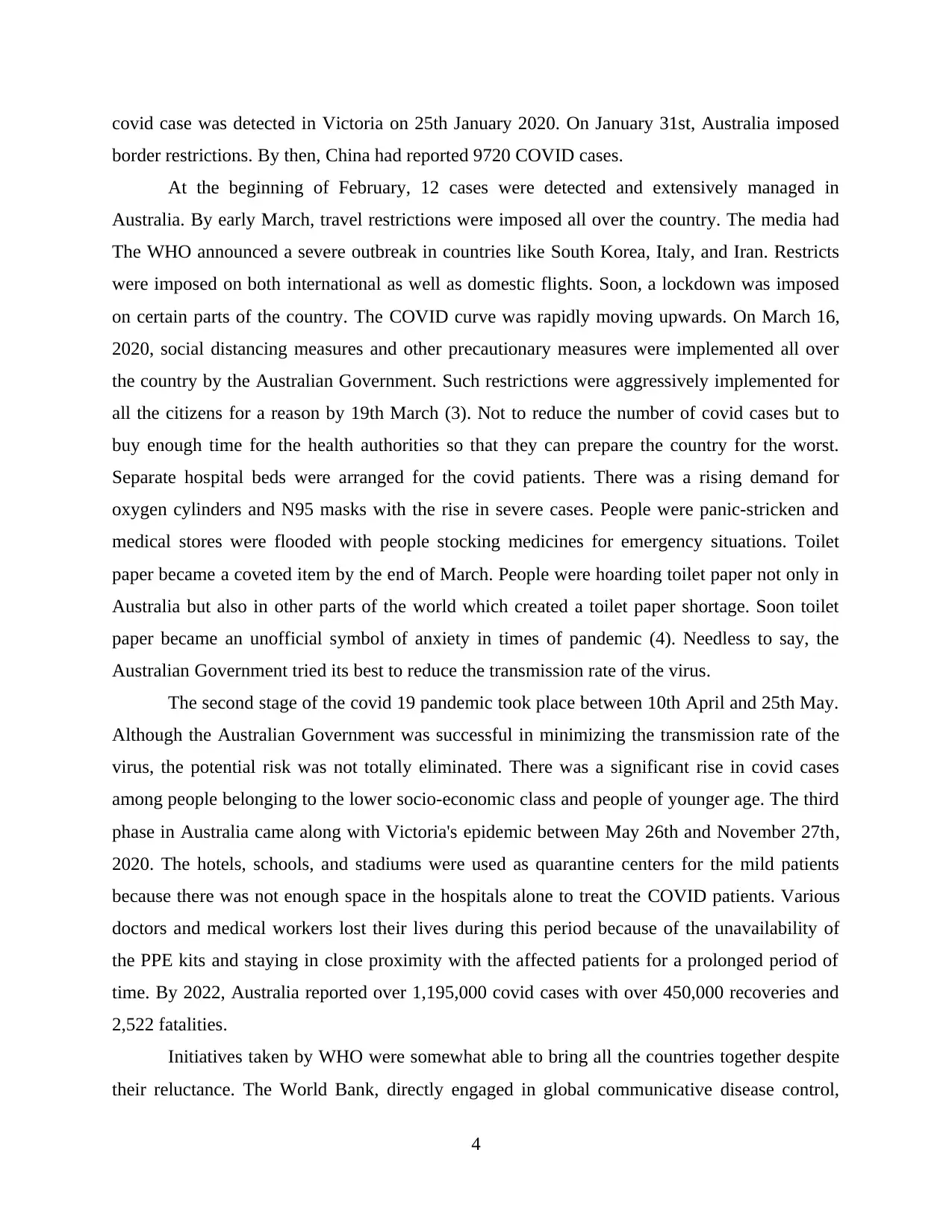
covid case was detected in Victoria on 25th January 2020. On January 31st, Australia imposed
border restrictions. By then, China had reported 9720 COVID cases.
At the beginning of February, 12 cases were detected and extensively managed in
Australia. By early March, travel restrictions were imposed all over the country. The media had
The WHO announced a severe outbreak in countries like South Korea, Italy, and Iran. Restricts
were imposed on both international as well as domestic flights. Soon, a lockdown was imposed
on certain parts of the country. The COVID curve was rapidly moving upwards. On March 16,
2020, social distancing measures and other precautionary measures were implemented all over
the country by the Australian Government. Such restrictions were aggressively implemented for
all the citizens for a reason by 19th March (3). Not to reduce the number of covid cases but to
buy enough time for the health authorities so that they can prepare the country for the worst.
Separate hospital beds were arranged for the covid patients. There was a rising demand for
oxygen cylinders and N95 masks with the rise in severe cases. People were panic-stricken and
medical stores were flooded with people stocking medicines for emergency situations. Toilet
paper became a coveted item by the end of March. People were hoarding toilet paper not only in
Australia but also in other parts of the world which created a toilet paper shortage. Soon toilet
paper became an unofficial symbol of anxiety in times of pandemic (4). Needless to say, the
Australian Government tried its best to reduce the transmission rate of the virus.
The second stage of the covid 19 pandemic took place between 10th April and 25th May.
Although the Australian Government was successful in minimizing the transmission rate of the
virus, the potential risk was not totally eliminated. There was a significant rise in covid cases
among people belonging to the lower socio-economic class and people of younger age. The third
phase in Australia came along with Victoria's epidemic between May 26th and November 27th,
2020. The hotels, schools, and stadiums were used as quarantine centers for the mild patients
because there was not enough space in the hospitals alone to treat the COVID patients. Various
doctors and medical workers lost their lives during this period because of the unavailability of
the PPE kits and staying in close proximity with the affected patients for a prolonged period of
time. By 2022, Australia reported over 1,195,000 covid cases with over 450,000 recoveries and
2,522 fatalities.
Initiatives taken by WHO were somewhat able to bring all the countries together despite
their reluctance. The World Bank, directly engaged in global communicative disease control,
4
border restrictions. By then, China had reported 9720 COVID cases.
At the beginning of February, 12 cases were detected and extensively managed in
Australia. By early March, travel restrictions were imposed all over the country. The media had
The WHO announced a severe outbreak in countries like South Korea, Italy, and Iran. Restricts
were imposed on both international as well as domestic flights. Soon, a lockdown was imposed
on certain parts of the country. The COVID curve was rapidly moving upwards. On March 16,
2020, social distancing measures and other precautionary measures were implemented all over
the country by the Australian Government. Such restrictions were aggressively implemented for
all the citizens for a reason by 19th March (3). Not to reduce the number of covid cases but to
buy enough time for the health authorities so that they can prepare the country for the worst.
Separate hospital beds were arranged for the covid patients. There was a rising demand for
oxygen cylinders and N95 masks with the rise in severe cases. People were panic-stricken and
medical stores were flooded with people stocking medicines for emergency situations. Toilet
paper became a coveted item by the end of March. People were hoarding toilet paper not only in
Australia but also in other parts of the world which created a toilet paper shortage. Soon toilet
paper became an unofficial symbol of anxiety in times of pandemic (4). Needless to say, the
Australian Government tried its best to reduce the transmission rate of the virus.
The second stage of the covid 19 pandemic took place between 10th April and 25th May.
Although the Australian Government was successful in minimizing the transmission rate of the
virus, the potential risk was not totally eliminated. There was a significant rise in covid cases
among people belonging to the lower socio-economic class and people of younger age. The third
phase in Australia came along with Victoria's epidemic between May 26th and November 27th,
2020. The hotels, schools, and stadiums were used as quarantine centers for the mild patients
because there was not enough space in the hospitals alone to treat the COVID patients. Various
doctors and medical workers lost their lives during this period because of the unavailability of
the PPE kits and staying in close proximity with the affected patients for a prolonged period of
time. By 2022, Australia reported over 1,195,000 covid cases with over 450,000 recoveries and
2,522 fatalities.
Initiatives taken by WHO were somewhat able to bring all the countries together despite
their reluctance. The World Bank, directly engaged in global communicative disease control,
4
Paraphrase This Document
Need a fresh take? Get an instant paraphrase of this document with our AI Paraphraser
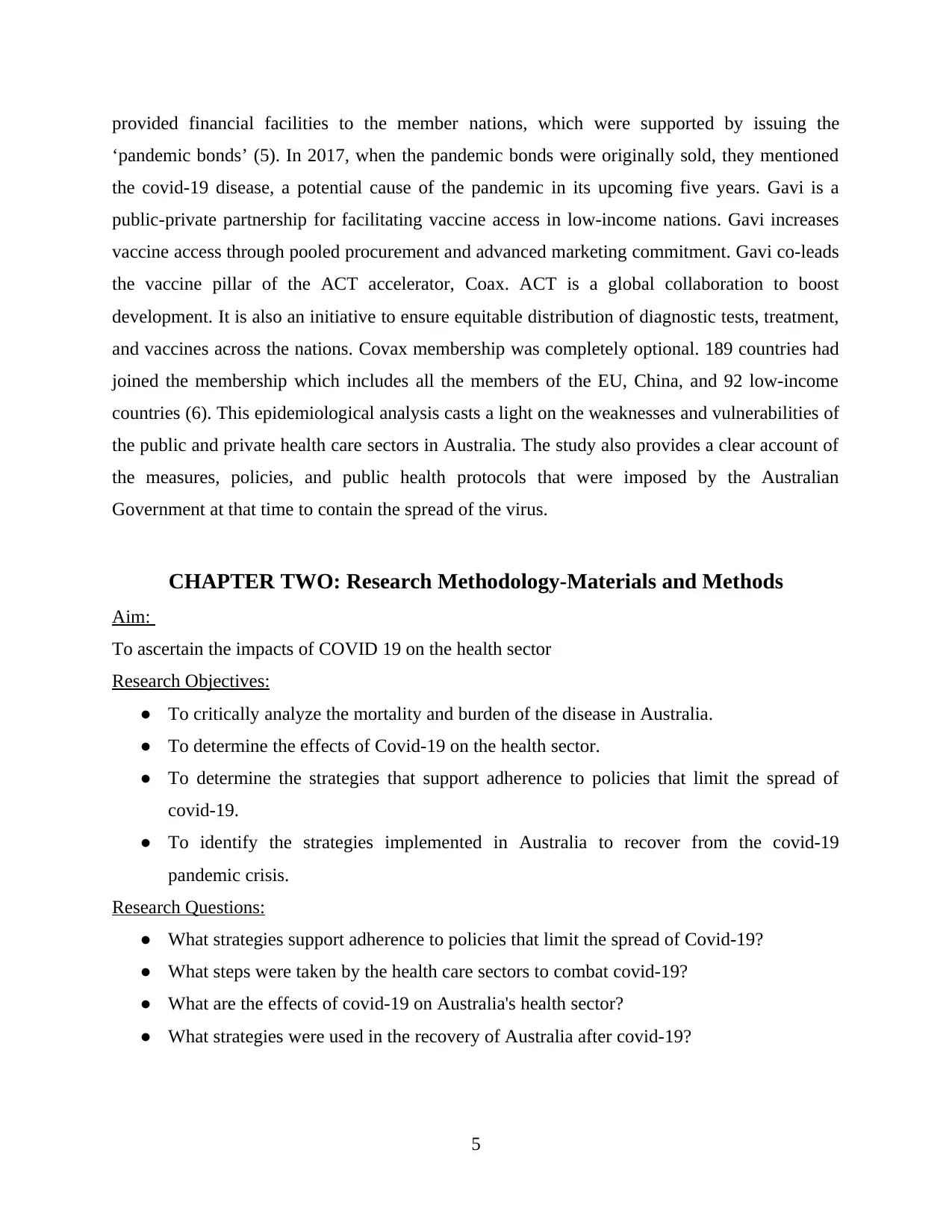
provided financial facilities to the member nations, which were supported by issuing the
‘pandemic bonds’ (5). In 2017, when the pandemic bonds were originally sold, they mentioned
the covid-19 disease, a potential cause of the pandemic in its upcoming five years. Gavi is a
public-private partnership for facilitating vaccine access in low-income nations. Gavi increases
vaccine access through pooled procurement and advanced marketing commitment. Gavi co-leads
the vaccine pillar of the ACT accelerator, Coax. ACT is a global collaboration to boost
development. It is also an initiative to ensure equitable distribution of diagnostic tests, treatment,
and vaccines across the nations. Covax membership was completely optional. 189 countries had
joined the membership which includes all the members of the EU, China, and 92 low-income
countries (6). This epidemiological analysis casts a light on the weaknesses and vulnerabilities of
the public and private health care sectors in Australia. The study also provides a clear account of
the measures, policies, and public health protocols that were imposed by the Australian
Government at that time to contain the spread of the virus.
CHAPTER TWO: Research Methodology-Materials and Methods
Aim:
To ascertain the impacts of COVID 19 on the health sector
Research Objectives:
● To critically analyze the mortality and burden of the disease in Australia.
● To determine the effects of Covid-19 on the health sector.
● To determine the strategies that support adherence to policies that limit the spread of
covid-19.
● To identify the strategies implemented in Australia to recover from the covid-19
pandemic crisis.
Research Questions:
● What strategies support adherence to policies that limit the spread of Covid-19?
● What steps were taken by the health care sectors to combat covid-19?
● What are the effects of covid-19 on Australia's health sector?
● What strategies were used in the recovery of Australia after covid-19?
5
‘pandemic bonds’ (5). In 2017, when the pandemic bonds were originally sold, they mentioned
the covid-19 disease, a potential cause of the pandemic in its upcoming five years. Gavi is a
public-private partnership for facilitating vaccine access in low-income nations. Gavi increases
vaccine access through pooled procurement and advanced marketing commitment. Gavi co-leads
the vaccine pillar of the ACT accelerator, Coax. ACT is a global collaboration to boost
development. It is also an initiative to ensure equitable distribution of diagnostic tests, treatment,
and vaccines across the nations. Covax membership was completely optional. 189 countries had
joined the membership which includes all the members of the EU, China, and 92 low-income
countries (6). This epidemiological analysis casts a light on the weaknesses and vulnerabilities of
the public and private health care sectors in Australia. The study also provides a clear account of
the measures, policies, and public health protocols that were imposed by the Australian
Government at that time to contain the spread of the virus.
CHAPTER TWO: Research Methodology-Materials and Methods
Aim:
To ascertain the impacts of COVID 19 on the health sector
Research Objectives:
● To critically analyze the mortality and burden of the disease in Australia.
● To determine the effects of Covid-19 on the health sector.
● To determine the strategies that support adherence to policies that limit the spread of
covid-19.
● To identify the strategies implemented in Australia to recover from the covid-19
pandemic crisis.
Research Questions:
● What strategies support adherence to policies that limit the spread of Covid-19?
● What steps were taken by the health care sectors to combat covid-19?
● What are the effects of covid-19 on Australia's health sector?
● What strategies were used in the recovery of Australia after covid-19?
5
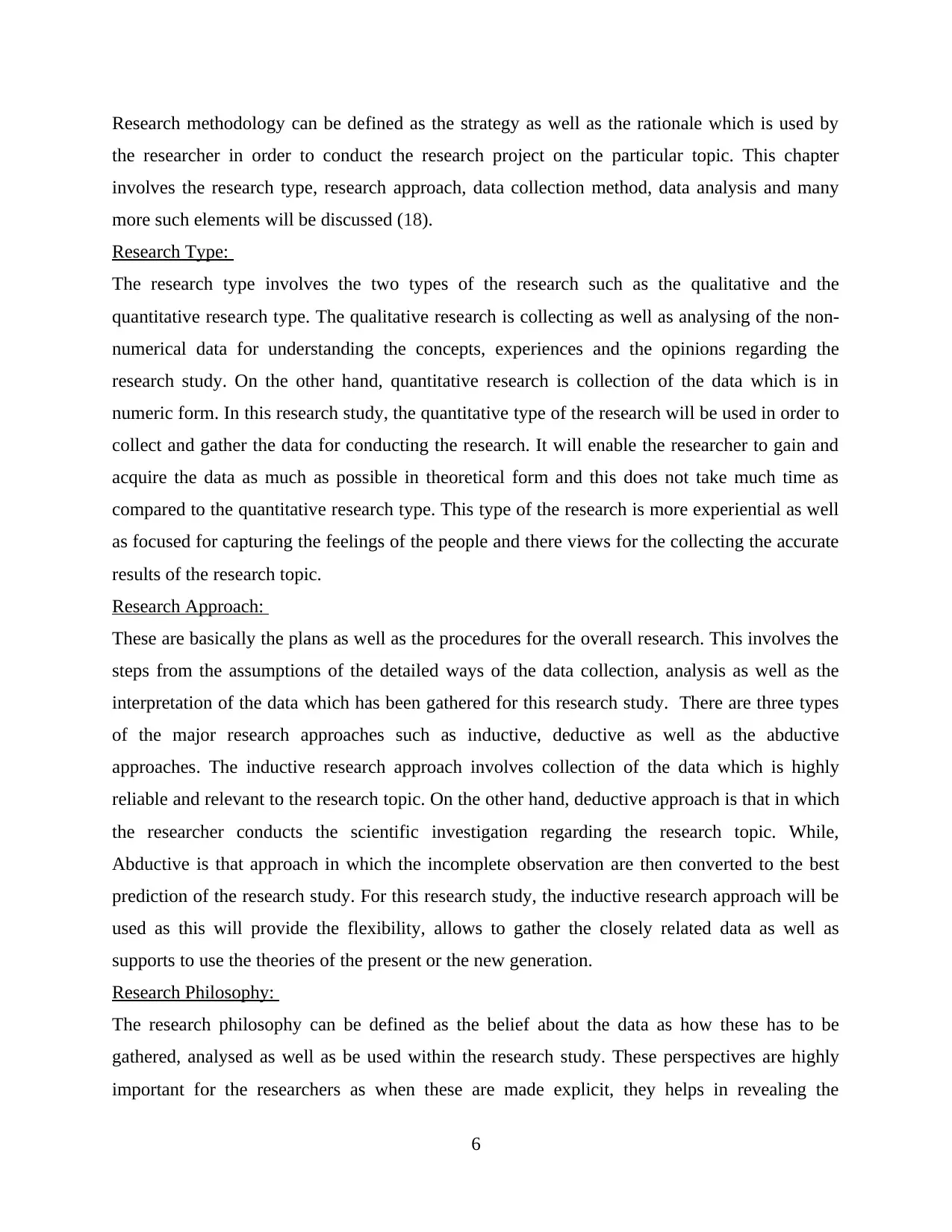
Research methodology can be defined as the strategy as well as the rationale which is used by
the researcher in order to conduct the research project on the particular topic. This chapter
involves the research type, research approach, data collection method, data analysis and many
more such elements will be discussed (18).
Research Type:
The research type involves the two types of the research such as the qualitative and the
quantitative research type. The qualitative research is collecting as well as analysing of the non-
numerical data for understanding the concepts, experiences and the opinions regarding the
research study. On the other hand, quantitative research is collection of the data which is in
numeric form. In this research study, the quantitative type of the research will be used in order to
collect and gather the data for conducting the research. It will enable the researcher to gain and
acquire the data as much as possible in theoretical form and this does not take much time as
compared to the quantitative research type. This type of the research is more experiential as well
as focused for capturing the feelings of the people and there views for the collecting the accurate
results of the research topic.
Research Approach:
These are basically the plans as well as the procedures for the overall research. This involves the
steps from the assumptions of the detailed ways of the data collection, analysis as well as the
interpretation of the data which has been gathered for this research study. There are three types
of the major research approaches such as inductive, deductive as well as the abductive
approaches. The inductive research approach involves collection of the data which is highly
reliable and relevant to the research topic. On the other hand, deductive approach is that in which
the researcher conducts the scientific investigation regarding the research topic. While,
Abductive is that approach in which the incomplete observation are then converted to the best
prediction of the research study. For this research study, the inductive research approach will be
used as this will provide the flexibility, allows to gather the closely related data as well as
supports to use the theories of the present or the new generation.
Research Philosophy:
The research philosophy can be defined as the belief about the data as how these has to be
gathered, analysed as well as be used within the research study. These perspectives are highly
important for the researchers as when these are made explicit, they helps in revealing the
6
the researcher in order to conduct the research project on the particular topic. This chapter
involves the research type, research approach, data collection method, data analysis and many
more such elements will be discussed (18).
Research Type:
The research type involves the two types of the research such as the qualitative and the
quantitative research type. The qualitative research is collecting as well as analysing of the non-
numerical data for understanding the concepts, experiences and the opinions regarding the
research study. On the other hand, quantitative research is collection of the data which is in
numeric form. In this research study, the quantitative type of the research will be used in order to
collect and gather the data for conducting the research. It will enable the researcher to gain and
acquire the data as much as possible in theoretical form and this does not take much time as
compared to the quantitative research type. This type of the research is more experiential as well
as focused for capturing the feelings of the people and there views for the collecting the accurate
results of the research topic.
Research Approach:
These are basically the plans as well as the procedures for the overall research. This involves the
steps from the assumptions of the detailed ways of the data collection, analysis as well as the
interpretation of the data which has been gathered for this research study. There are three types
of the major research approaches such as inductive, deductive as well as the abductive
approaches. The inductive research approach involves collection of the data which is highly
reliable and relevant to the research topic. On the other hand, deductive approach is that in which
the researcher conducts the scientific investigation regarding the research topic. While,
Abductive is that approach in which the incomplete observation are then converted to the best
prediction of the research study. For this research study, the inductive research approach will be
used as this will provide the flexibility, allows to gather the closely related data as well as
supports to use the theories of the present or the new generation.
Research Philosophy:
The research philosophy can be defined as the belief about the data as how these has to be
gathered, analysed as well as be used within the research study. These perspectives are highly
important for the researchers as when these are made explicit, they helps in revealing the
6
⊘ This is a preview!⊘
Do you want full access?
Subscribe today to unlock all pages.

Trusted by 1+ million students worldwide
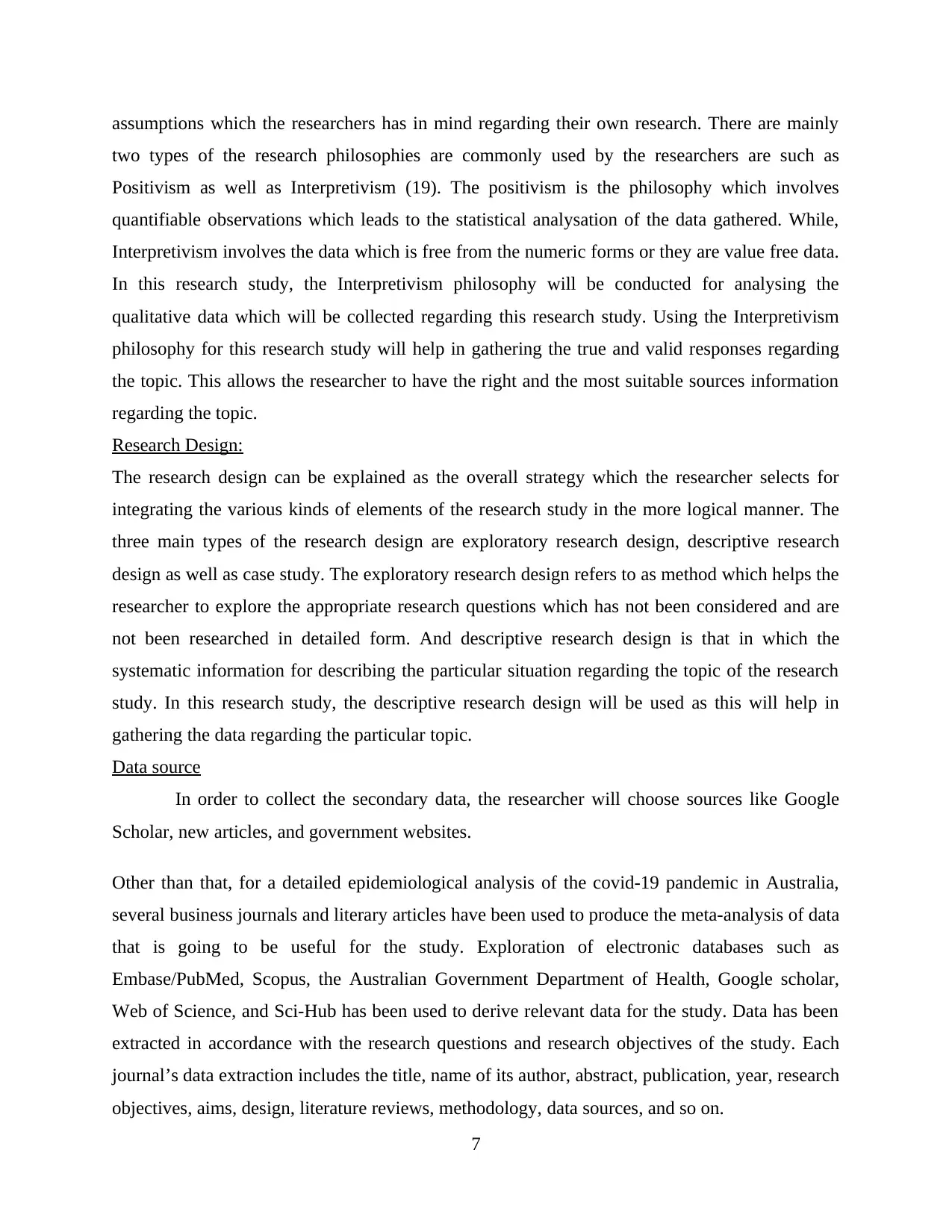
assumptions which the researchers has in mind regarding their own research. There are mainly
two types of the research philosophies are commonly used by the researchers are such as
Positivism as well as Interpretivism (19). The positivism is the philosophy which involves
quantifiable observations which leads to the statistical analysation of the data gathered. While,
Interpretivism involves the data which is free from the numeric forms or they are value free data.
In this research study, the Interpretivism philosophy will be conducted for analysing the
qualitative data which will be collected regarding this research study. Using the Interpretivism
philosophy for this research study will help in gathering the true and valid responses regarding
the topic. This allows the researcher to have the right and the most suitable sources information
regarding the topic.
Research Design:
The research design can be explained as the overall strategy which the researcher selects for
integrating the various kinds of elements of the research study in the more logical manner. The
three main types of the research design are exploratory research design, descriptive research
design as well as case study. The exploratory research design refers to as method which helps the
researcher to explore the appropriate research questions which has not been considered and are
not been researched in detailed form. And descriptive research design is that in which the
systematic information for describing the particular situation regarding the topic of the research
study. In this research study, the descriptive research design will be used as this will help in
gathering the data regarding the particular topic.
Data source
In order to collect the secondary data, the researcher will choose sources like Google
Scholar, new articles, and government websites.
Other than that, for a detailed epidemiological analysis of the covid-19 pandemic in Australia,
several business journals and literary articles have been used to produce the meta-analysis of data
that is going to be useful for the study. Exploration of electronic databases such as
Embase/PubMed, Scopus, the Australian Government Department of Health, Google scholar,
Web of Science, and Sci-Hub has been used to derive relevant data for the study. Data has been
extracted in accordance with the research questions and research objectives of the study. Each
journal’s data extraction includes the title, name of its author, abstract, publication, year, research
objectives, aims, design, literature reviews, methodology, data sources, and so on.
7
two types of the research philosophies are commonly used by the researchers are such as
Positivism as well as Interpretivism (19). The positivism is the philosophy which involves
quantifiable observations which leads to the statistical analysation of the data gathered. While,
Interpretivism involves the data which is free from the numeric forms or they are value free data.
In this research study, the Interpretivism philosophy will be conducted for analysing the
qualitative data which will be collected regarding this research study. Using the Interpretivism
philosophy for this research study will help in gathering the true and valid responses regarding
the topic. This allows the researcher to have the right and the most suitable sources information
regarding the topic.
Research Design:
The research design can be explained as the overall strategy which the researcher selects for
integrating the various kinds of elements of the research study in the more logical manner. The
three main types of the research design are exploratory research design, descriptive research
design as well as case study. The exploratory research design refers to as method which helps the
researcher to explore the appropriate research questions which has not been considered and are
not been researched in detailed form. And descriptive research design is that in which the
systematic information for describing the particular situation regarding the topic of the research
study. In this research study, the descriptive research design will be used as this will help in
gathering the data regarding the particular topic.
Data source
In order to collect the secondary data, the researcher will choose sources like Google
Scholar, new articles, and government websites.
Other than that, for a detailed epidemiological analysis of the covid-19 pandemic in Australia,
several business journals and literary articles have been used to produce the meta-analysis of data
that is going to be useful for the study. Exploration of electronic databases such as
Embase/PubMed, Scopus, the Australian Government Department of Health, Google scholar,
Web of Science, and Sci-Hub has been used to derive relevant data for the study. Data has been
extracted in accordance with the research questions and research objectives of the study. Each
journal’s data extraction includes the title, name of its author, abstract, publication, year, research
objectives, aims, design, literature reviews, methodology, data sources, and so on.
7
Paraphrase This Document
Need a fresh take? Get an instant paraphrase of this document with our AI Paraphraser
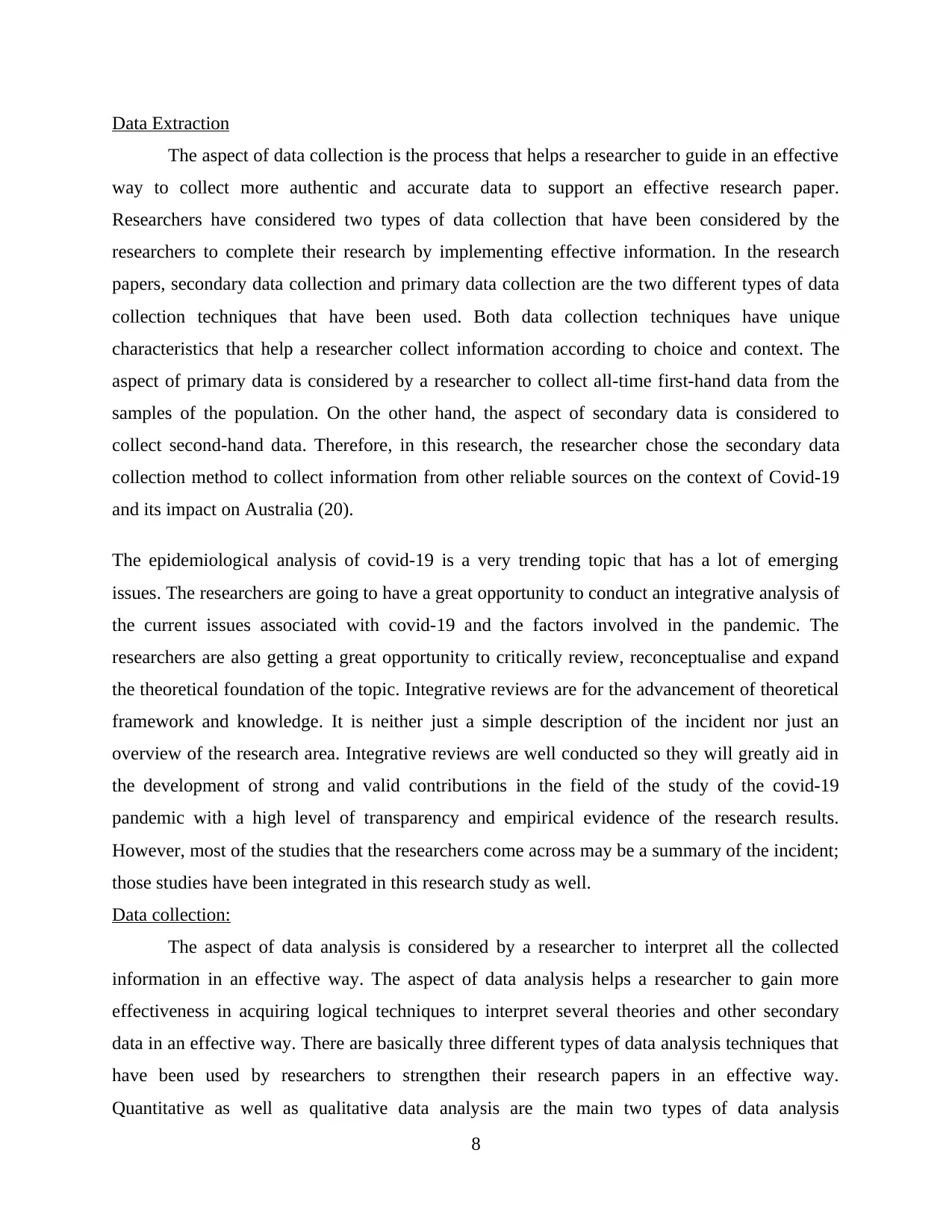
Data Extraction
The aspect of data collection is the process that helps a researcher to guide in an effective
way to collect more authentic and accurate data to support an effective research paper.
Researchers have considered two types of data collection that have been considered by the
researchers to complete their research by implementing effective information. In the research
papers, secondary data collection and primary data collection are the two different types of data
collection techniques that have been used. Both data collection techniques have unique
characteristics that help a researcher collect information according to choice and context. The
aspect of primary data is considered by a researcher to collect all-time first-hand data from the
samples of the population. On the other hand, the aspect of secondary data is considered to
collect second-hand data. Therefore, in this research, the researcher chose the secondary data
collection method to collect information from other reliable sources on the context of Covid-19
and its impact on Australia (20).
The epidemiological analysis of covid-19 is a very trending topic that has a lot of emerging
issues. The researchers are going to have a great opportunity to conduct an integrative analysis of
the current issues associated with covid-19 and the factors involved in the pandemic. The
researchers are also getting a great opportunity to critically review, reconceptualise and expand
the theoretical foundation of the topic. Integrative reviews are for the advancement of theoretical
framework and knowledge. It is neither just a simple description of the incident nor just an
overview of the research area. Integrative reviews are well conducted so they will greatly aid in
the development of strong and valid contributions in the field of the study of the covid-19
pandemic with a high level of transparency and empirical evidence of the research results.
However, most of the studies that the researchers come across may be a summary of the incident;
those studies have been integrated in this research study as well.
Data collection:
The aspect of data analysis is considered by a researcher to interpret all the collected
information in an effective way. The aspect of data analysis helps a researcher to gain more
effectiveness in acquiring logical techniques to interpret several theories and other secondary
data in an effective way. There are basically three different types of data analysis techniques that
have been used by researchers to strengthen their research papers in an effective way.
Quantitative as well as qualitative data analysis are the main two types of data analysis
8
The aspect of data collection is the process that helps a researcher to guide in an effective
way to collect more authentic and accurate data to support an effective research paper.
Researchers have considered two types of data collection that have been considered by the
researchers to complete their research by implementing effective information. In the research
papers, secondary data collection and primary data collection are the two different types of data
collection techniques that have been used. Both data collection techniques have unique
characteristics that help a researcher collect information according to choice and context. The
aspect of primary data is considered by a researcher to collect all-time first-hand data from the
samples of the population. On the other hand, the aspect of secondary data is considered to
collect second-hand data. Therefore, in this research, the researcher chose the secondary data
collection method to collect information from other reliable sources on the context of Covid-19
and its impact on Australia (20).
The epidemiological analysis of covid-19 is a very trending topic that has a lot of emerging
issues. The researchers are going to have a great opportunity to conduct an integrative analysis of
the current issues associated with covid-19 and the factors involved in the pandemic. The
researchers are also getting a great opportunity to critically review, reconceptualise and expand
the theoretical foundation of the topic. Integrative reviews are for the advancement of theoretical
framework and knowledge. It is neither just a simple description of the incident nor just an
overview of the research area. Integrative reviews are well conducted so they will greatly aid in
the development of strong and valid contributions in the field of the study of the covid-19
pandemic with a high level of transparency and empirical evidence of the research results.
However, most of the studies that the researchers come across may be a summary of the incident;
those studies have been integrated in this research study as well.
Data collection:
The aspect of data analysis is considered by a researcher to interpret all the collected
information in an effective way. The aspect of data analysis helps a researcher to gain more
effectiveness in acquiring logical techniques to interpret several theories and other secondary
data in an effective way. There are basically three different types of data analysis techniques that
have been used by researchers to strengthen their research papers in an effective way.
Quantitative as well as qualitative data analysis are the main two types of data analysis
8
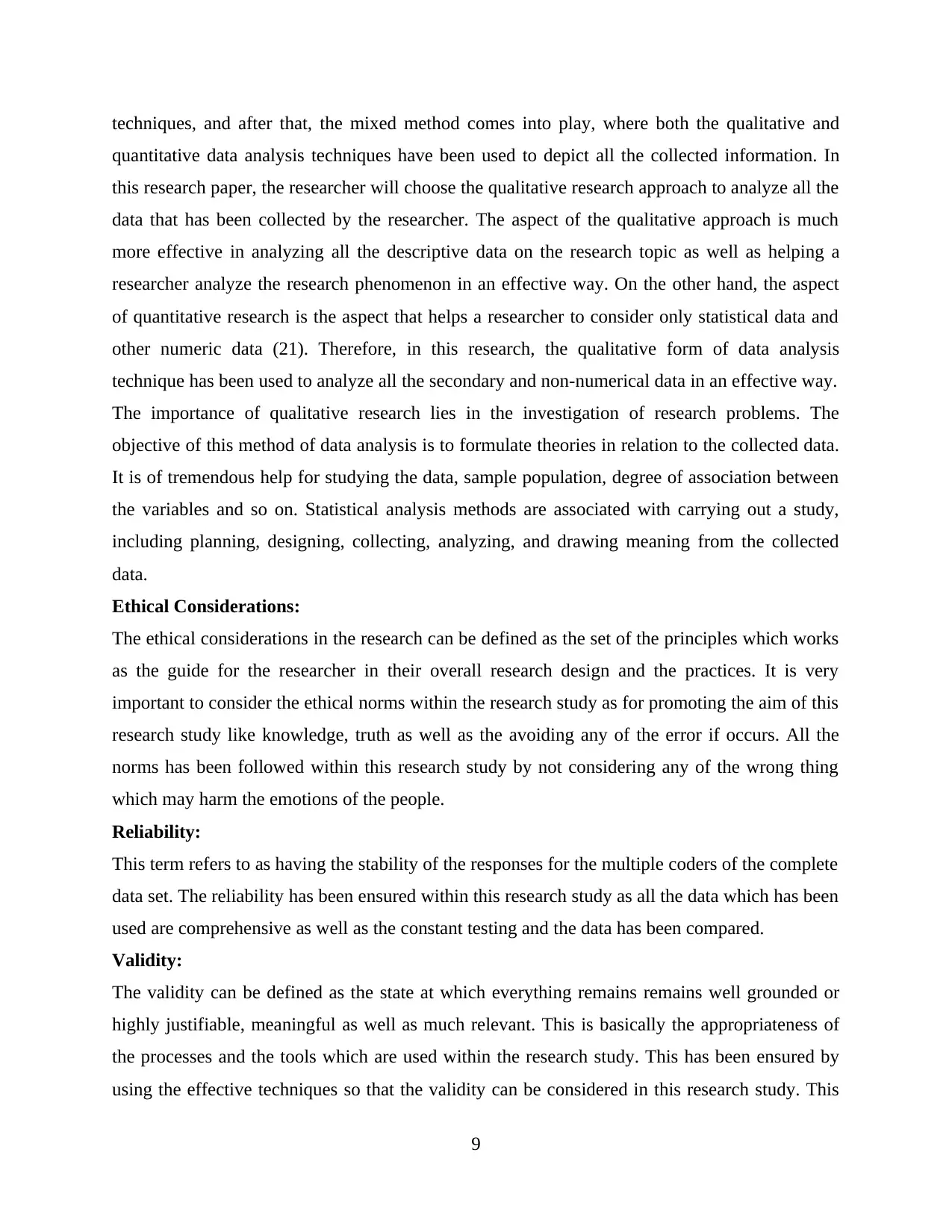
techniques, and after that, the mixed method comes into play, where both the qualitative and
quantitative data analysis techniques have been used to depict all the collected information. In
this research paper, the researcher will choose the qualitative research approach to analyze all the
data that has been collected by the researcher. The aspect of the qualitative approach is much
more effective in analyzing all the descriptive data on the research topic as well as helping a
researcher analyze the research phenomenon in an effective way. On the other hand, the aspect
of quantitative research is the aspect that helps a researcher to consider only statistical data and
other numeric data (21). Therefore, in this research, the qualitative form of data analysis
technique has been used to analyze all the secondary and non-numerical data in an effective way.
The importance of qualitative research lies in the investigation of research problems. The
objective of this method of data analysis is to formulate theories in relation to the collected data.
It is of tremendous help for studying the data, sample population, degree of association between
the variables and so on. Statistical analysis methods are associated with carrying out a study,
including planning, designing, collecting, analyzing, and drawing meaning from the collected
data.
Ethical Considerations:
The ethical considerations in the research can be defined as the set of the principles which works
as the guide for the researcher in their overall research design and the practices. It is very
important to consider the ethical norms within the research study as for promoting the aim of this
research study like knowledge, truth as well as the avoiding any of the error if occurs. All the
norms has been followed within this research study by not considering any of the wrong thing
which may harm the emotions of the people.
Reliability:
This term refers to as having the stability of the responses for the multiple coders of the complete
data set. The reliability has been ensured within this research study as all the data which has been
used are comprehensive as well as the constant testing and the data has been compared.
Validity:
The validity can be defined as the state at which everything remains remains well grounded or
highly justifiable, meaningful as well as much relevant. This is basically the appropriateness of
the processes and the tools which are used within the research study. This has been ensured by
using the effective techniques so that the validity can be considered in this research study. This
9
quantitative data analysis techniques have been used to depict all the collected information. In
this research paper, the researcher will choose the qualitative research approach to analyze all the
data that has been collected by the researcher. The aspect of the qualitative approach is much
more effective in analyzing all the descriptive data on the research topic as well as helping a
researcher analyze the research phenomenon in an effective way. On the other hand, the aspect
of quantitative research is the aspect that helps a researcher to consider only statistical data and
other numeric data (21). Therefore, in this research, the qualitative form of data analysis
technique has been used to analyze all the secondary and non-numerical data in an effective way.
The importance of qualitative research lies in the investigation of research problems. The
objective of this method of data analysis is to formulate theories in relation to the collected data.
It is of tremendous help for studying the data, sample population, degree of association between
the variables and so on. Statistical analysis methods are associated with carrying out a study,
including planning, designing, collecting, analyzing, and drawing meaning from the collected
data.
Ethical Considerations:
The ethical considerations in the research can be defined as the set of the principles which works
as the guide for the researcher in their overall research design and the practices. It is very
important to consider the ethical norms within the research study as for promoting the aim of this
research study like knowledge, truth as well as the avoiding any of the error if occurs. All the
norms has been followed within this research study by not considering any of the wrong thing
which may harm the emotions of the people.
Reliability:
This term refers to as having the stability of the responses for the multiple coders of the complete
data set. The reliability has been ensured within this research study as all the data which has been
used are comprehensive as well as the constant testing and the data has been compared.
Validity:
The validity can be defined as the state at which everything remains remains well grounded or
highly justifiable, meaningful as well as much relevant. This is basically the appropriateness of
the processes and the tools which are used within the research study. This has been ensured by
using the effective techniques so that the validity can be considered in this research study. This
9
⊘ This is a preview!⊘
Do you want full access?
Subscribe today to unlock all pages.

Trusted by 1+ million students worldwide
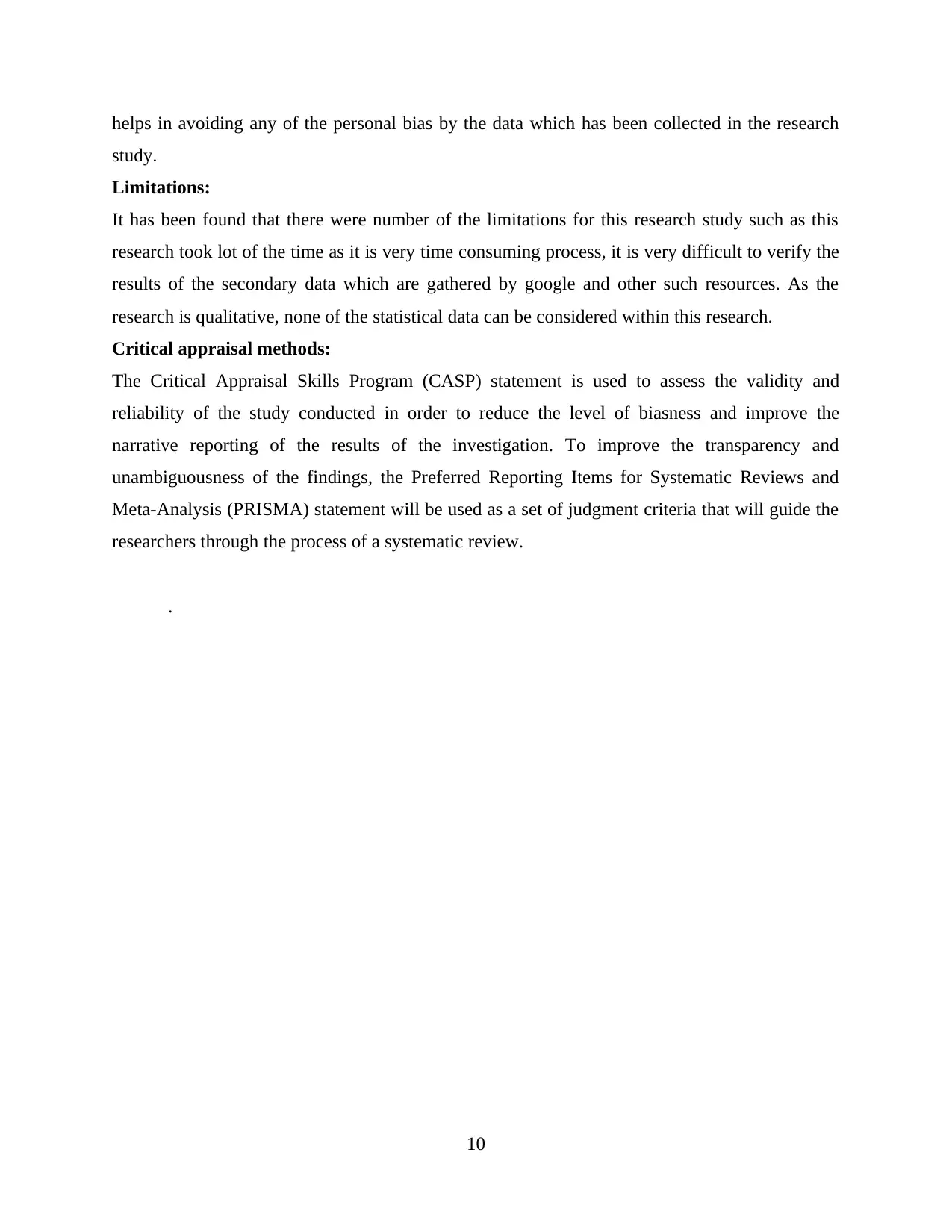
helps in avoiding any of the personal bias by the data which has been collected in the research
study.
Limitations:
It has been found that there were number of the limitations for this research study such as this
research took lot of the time as it is very time consuming process, it is very difficult to verify the
results of the secondary data which are gathered by google and other such resources. As the
research is qualitative, none of the statistical data can be considered within this research.
Critical appraisal methods:
The Critical Appraisal Skills Program (CASP) statement is used to assess the validity and
reliability of the study conducted in order to reduce the level of biasness and improve the
narrative reporting of the results of the investigation. To improve the transparency and
unambiguousness of the findings, the Preferred Reporting Items for Systematic Reviews and
Meta-Analysis (PRISMA) statement will be used as a set of judgment criteria that will guide the
researchers through the process of a systematic review.
.
10
study.
Limitations:
It has been found that there were number of the limitations for this research study such as this
research took lot of the time as it is very time consuming process, it is very difficult to verify the
results of the secondary data which are gathered by google and other such resources. As the
research is qualitative, none of the statistical data can be considered within this research.
Critical appraisal methods:
The Critical Appraisal Skills Program (CASP) statement is used to assess the validity and
reliability of the study conducted in order to reduce the level of biasness and improve the
narrative reporting of the results of the investigation. To improve the transparency and
unambiguousness of the findings, the Preferred Reporting Items for Systematic Reviews and
Meta-Analysis (PRISMA) statement will be used as a set of judgment criteria that will guide the
researchers through the process of a systematic review.
.
10
1 out of 10
Related Documents
Your All-in-One AI-Powered Toolkit for Academic Success.
+13062052269
info@desklib.com
Available 24*7 on WhatsApp / Email
![[object Object]](/_next/static/media/star-bottom.7253800d.svg)
Unlock your academic potential
Copyright © 2020–2025 A2Z Services. All Rights Reserved. Developed and managed by ZUCOL.





